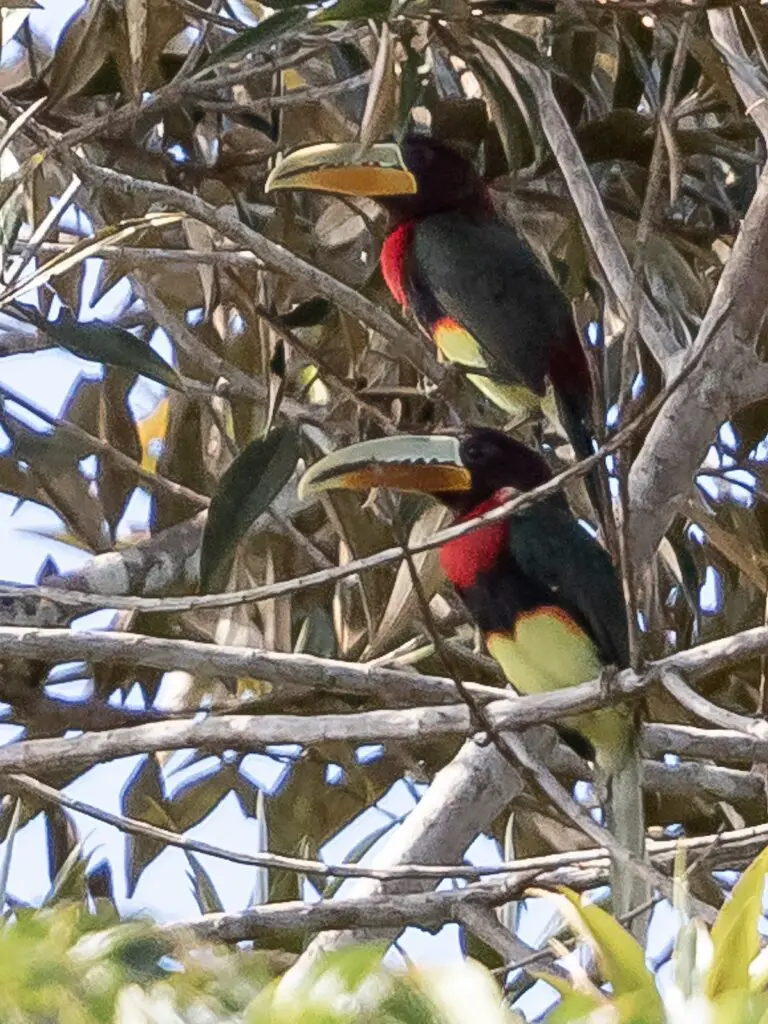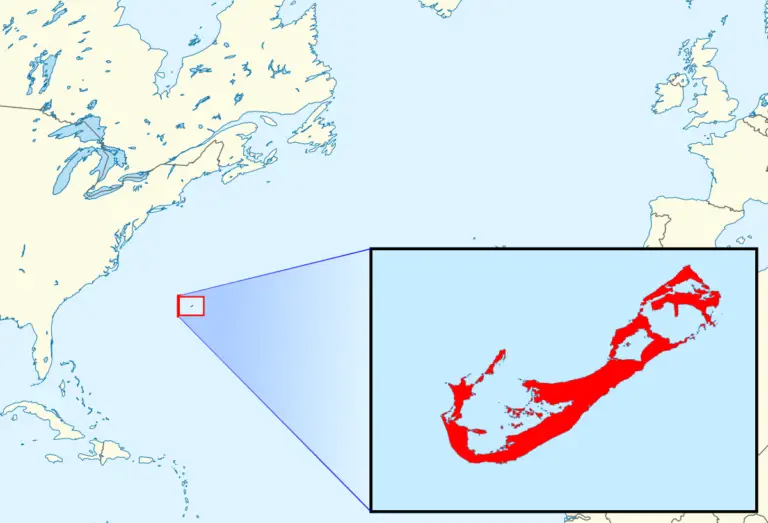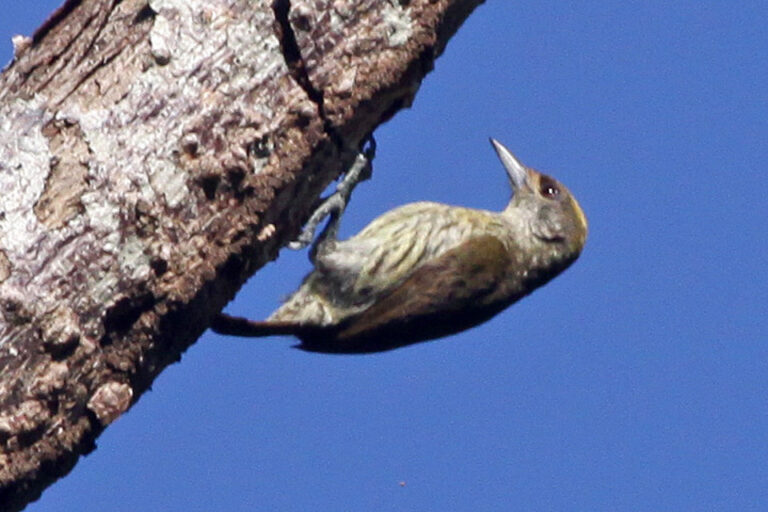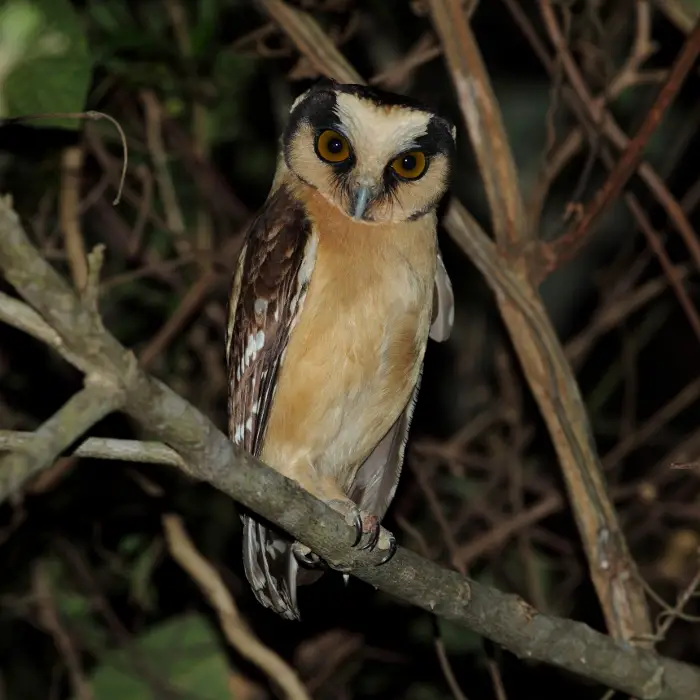Egyptian Vulture (Neophron Percnopterus) Birds
Scientific Classification
[table id=3 /]“They are skilled at locating carrion using both sight and smell. While many birds of prey rely primarily on their keen eyesight to locate food, Egyptian Vultures also have a well-developed sense of smell. They can detect the odor of decaying flesh from great distances, which helps them locate potential food sources more efficiently, especially in vast and open landscapes. This combination of visual and olfactory abilities makes them highly effective scavengers and contributes to their success in finding food in diverse environments.”
The Egyptian vulture, a bird species native to Egypt and other regions, is both culturally significant and biologically fascinating. In ancient Egyptian mythology, it was revered as a symbol of goddesses like Nekhbet and depicted in various forms of art and symbolism, including hieroglyphs, crowns, and headdresses. Today, however, the Egyptian vulture faces numerous threats, leading to its classification as an endangered species. Efforts are underway to conserve its population and habitat. Understanding its diet, habitat requirements, and behavioral patterns is crucial for conservation efforts. Additionally, the species’ size, wingspan, and scientific name provide valuable insights for researchers. Despite its endangered status, the Egyptian vulture continues to capture the imagination of people worldwide, inspiring everything from tattoos to artistic representations.
The Egyptian Vulture (Neophron percnopterus) is a distinctive bird of prey, easily recognized by its contrasting plumage and characteristic flight silhouette. Here is its scientific classification and conservation status:
Conservation Status
- Endangered
Geographic Locations
- Africa
- Asia
- Eurasia
- Europe
This species is known for its wide distribution across several continents, inhabiting a variety of environments from deserts to mountains. The status of being endangered highlights the significant threats this bird faces, including habitat loss, poisoning, and human disturbances. Conservation efforts are crucial for the survival of this unique and ecologically important species.
The Egyptian Vulture (Neophron percnopterus) is a fascinating and distinctive bird. Here are some detailed facts about this species:
Diet and Prey
- Prey: Carrion, small mammals, birds, and reptiles
- Main Prey: Carrion
Reproduction and Development
- Name of Young: Chicks
- Incubation Period: 42 to 47 days
- Age of Fledgling: 90 to 110 days
- Average Clutch Size: 2
- Nesting Location: Cliff ledges, buildings, forks of large trees
- Age of Molting: Four to five years
Behavior
- Group Behavior: Solitary or pairs
- Lifestyle: Diurnal (active during the day)
- Migratory: Yes
Fun Facts
- Interesting Behavior: They steal large ostrich eggs and use rocks and pebbles to crack the shells.
Physical Characteristics
- Most Distinctive Feature: Long, hooked bill
- Distinctive Features: Long neck feathers, pointed wings
- Color: Yellow, black, and white
- Wingspan: 4.9 to 5.1 feet
- Length: 19 to 26 inches
- Weight: 4.2 to 5.3 pounds
- Skin Type: Feathers
- Lifespan: Up to 37 years
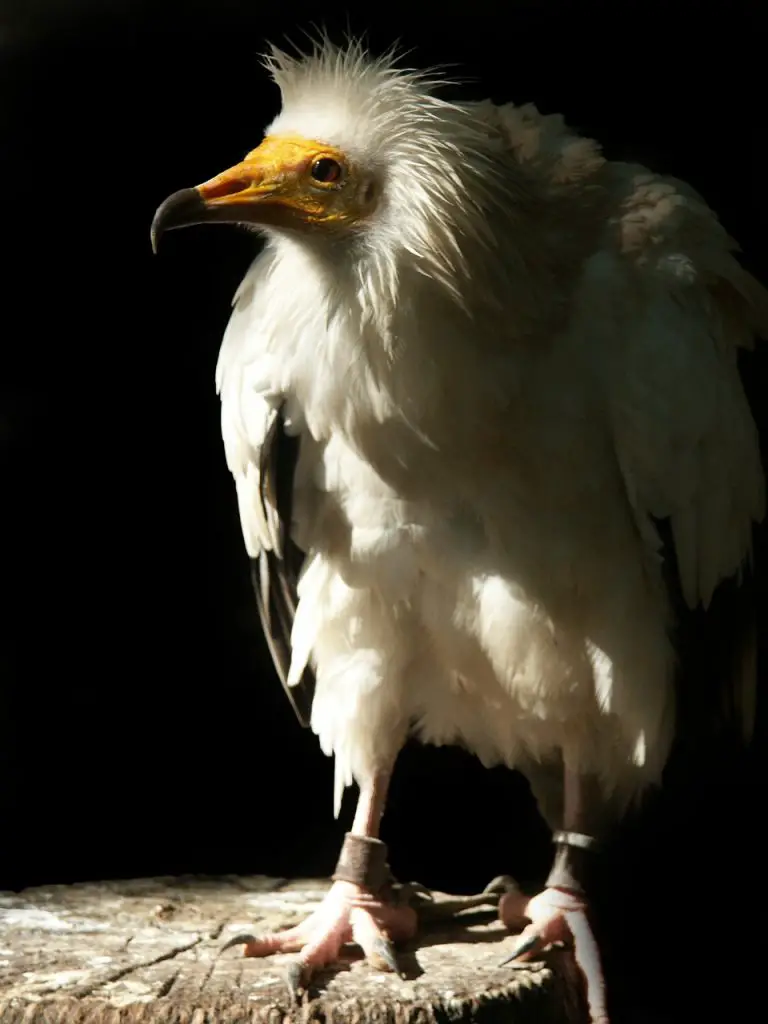
Population and Conservation
- Estimated Population Size: 12,000 to 36,000
- Biggest Threats: Poisoning, electrocution, and collisions
- Conservation Status: Endangered
Habitat
- Habitat: Deserts, fields, and pastures
- Geographic Locations: Africa, Asia, Europe
Predators
- Natural Predators: Red foxes, golden eagles, jackals, wolves, and eagle owls
Diet Type
- Diet Type: Carnivore
- Special Features: Hooked mandible
Number of Species
- Number of Species: 3
This species is remarkable for its unique feeding habits and adaptation to a variety of habitats. Conservation efforts are essential to protect this endangered bird from further decline due to human-related threats.
5 Amazing Egyptian Vulture Facts
Here are five amazing facts about the Egyptian Vulture (Neophron percnopterus):
- Scavengers in Human Habitats:
- Egyptian Vultures often frequent human garbage dumps and fishing ports, looking for an easy meal. Their adaptability to human-altered environments showcases their opportunistic feeding behavior.
- Nesting Tools:
- These vultures exhibit remarkable tool use by rolling up wool with sticks to construct their nests. This behavior highlights their intelligence and resourcefulness.
- Egg Cracking Technique:
- They are known for stealing large ostrich eggs and using rocks and pebbles to crack the shells. This unique behavior demonstrates their problem-solving skills and ability to use tools.
- Vocalizations:
- Egyptian Vultures are relatively silent but can occasionally produce high-pitched hissing and screeching noises, particularly at their nest or near food sources. Their vocal behavior is less pronounced compared to other vulture species.
- Endangered Status:
- This species is endangered due to numerous threats, including poisoning, electrocution, and collisions with power lines and wind turbines. Conservation efforts are crucial to mitigate these risks and protect the remaining population.
These facts illustrate the Egyptian Vulture’s unique adaptations, intelligence, and the urgent need for conservation measures to ensure their survival.
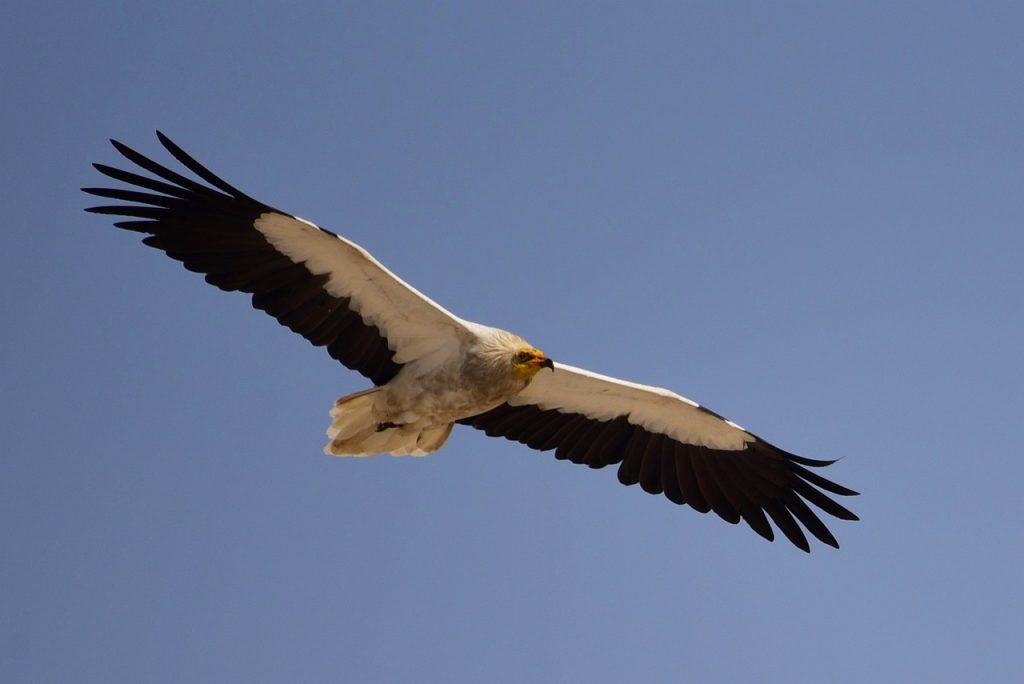
Where to Find the Egyptian Vulture
The Egyptian Vulture (Neophron percnopterus) is a remarkable bird known for its wide distribution and unique behaviors. Here are some detailed insights about its habitat, nesting habits, and interactions with humans:
Habitat and Distribution
- Geographic Range: The Egyptian Vulture lives in over 65 countries across Africa, Asia, and Europe, including nations such as India, Turkey, Saudi Arabia, Chad, Sudan, and Ethiopia.
- Migration: This species is migratory, breeding in regions like North Africa, Southern Europe, and Asia, and wintering at the southern edge of the Sahara.
- Preferred Habitats: They inhabit arid open areas such as deserts, fields, and pastures. However, they also require proximity to rocky areas for nesting purposes.
- Human Proximity: Egyptian Vultures often live near human settlements, utilizing garbage dumps, fishing ports, and slaughterhouses as food sources. This behavior indicates their adaptability and opportunistic feeding strategies.
Behavior
- Soaring and Feeding: Look for Egyptian Vultures soaring high in the sky, alone or in pairs, or on the ground around a carcass, often alongside mixed vulture species.
Nesting
- Nest Structure: Their nests are typically untidy platforms made from twigs and lined with rags. These nests are usually constructed on cliff ledges, buildings, or in the forks of large trees.
- Nest Building: Researchers have observed that Egyptian Vultures use sticks to roll up wool for their nests, showcasing their innovative use of materials. Occasionally, they might also take over old eagle nests.
These characteristics highlight the Egyptian Vulture’s adaptability, resourcefulness, and the diverse range of environments it can inhabit. Conservation efforts are vital to protect this endangered species and ensure its survival across its extensive range.
Scientific Name
The Egyptian vulture (Neophron percnopterus) belongs to the Accipitridae family, which includes a range of birds of prey, from small to large, all with strong, hooked bills and diverse diets. This vulture is unique as the sole species in the Neophron genus, making it the oldest branch on the vulture evolutionary tree. Interestingly, “Percnopterus” translates from Greek to “black wings.” There are three recognized subspecies of the Egyptian vulture.
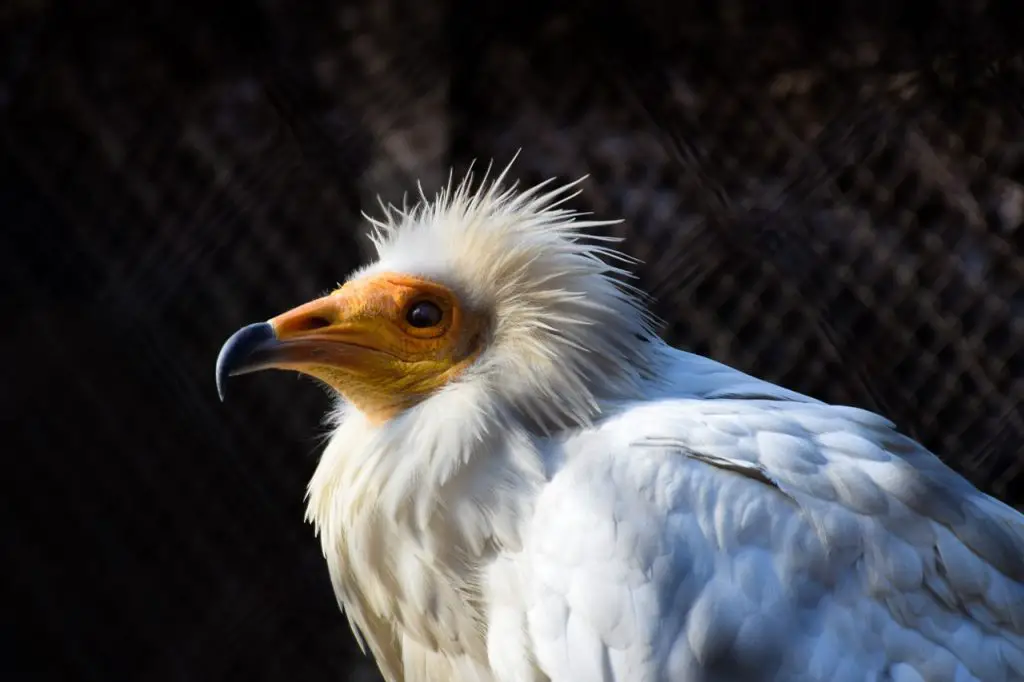
Size, Appearance, & Behavior
The Egyptian vulture is a small Old World vulture, measuring 19 to 26 inches in length and weighing between 4.2 and 5.3 pounds, with an impressive wingspan of 4.9 to 5.1 feet. It features a long, slender bill with a hooked upper mandible and elongated nostril slits. This vulture also has distinctive long neck feathers that form a plume, a wedge-shaped tail, and pointed wings.
Adults are primarily white with black flight feathers, although their plumage often appears brown due to iron-rich soil in their habitats. Their facial skin is yellow and unfeathered, and their bills are black. Male and female Egyptian vultures have identical plumage, but females are slightly larger. Juvenile vultures are black or brown with black and white patches.
These birds are typically solitary or seen in pairs, though they roost in communal areas, which helps them locate food more efficiently. While generally silent, they can produce high-pitched hissing noises at their nests and screeching sounds when near a carcass.
Migration Pattern and Timing
The Egyptian vulture is a long-distance migrant and stands out as Europe’s only migratory vulture. Their breeding range extends from Southern Europe and Northern Africa to Western and Southern Asia. During migration, they travel to the southern edge of the Sahara, with some individuals reaching as far south as South Africa. These vultures are capable of covering over 300 miles in a single day. However, they tend to avoid long stretches of open water, preferring routes that pass over islands and peninsulas.

Diet
Egyptian vultures are carnivores and opportunistic predators. They primarily feed on carrion but will also hunt small mammals, birds, and reptiles when the opportunity arises. This adaptability in their diet helps them survive in various environments and makes them an essential part of the ecosystem by helping to clean up carcasses and waste.
What Does the Egyptian Vulture Eat?
Egyptian vultures primarily eat carrion (dead animals) but are known to consume small mammals, birds, and reptiles. They have a unique diet that includes mammal feces, even human feces. These vultures will steal eggs from other birds and are famously known for breaking large ostrich eggs using jagged rocks and pebbles, which they hurl down until the egg cracks open. They hunt by sight, soaring high in the sky and scanning the ground for carcasses in open areas. Often, they follow other vultures circling a meal but typically wait on the sidelines until the larger vultures have finished eating.
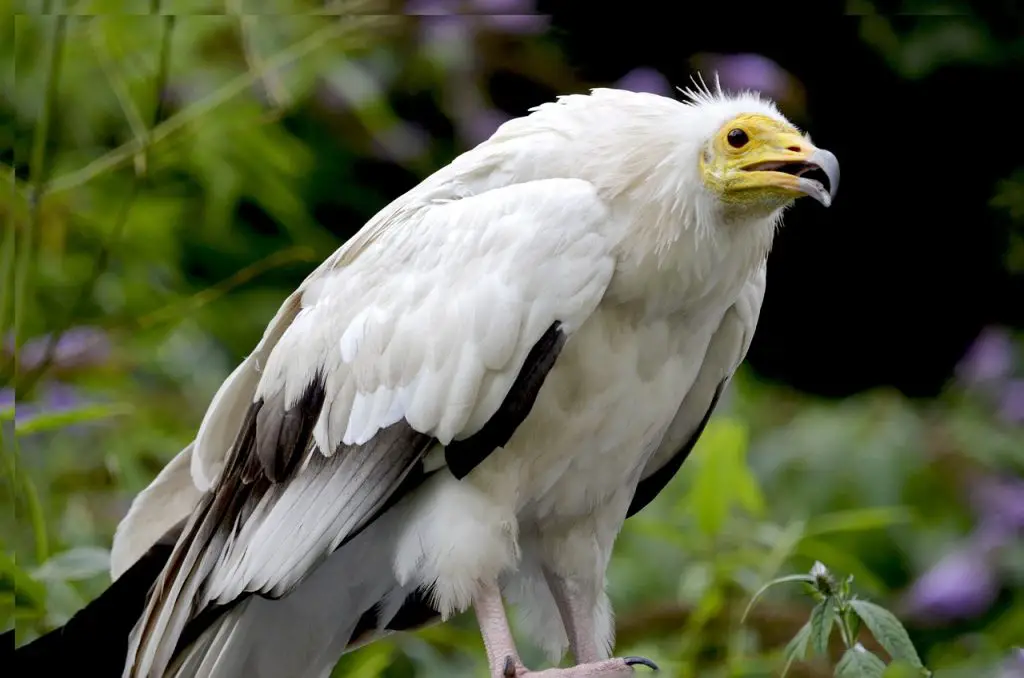
Predators, Threats, and Conservation Status
The International Union for Conservation of Nature (IUCN) classifies the Egyptian vulture as “endangered” (EN). This severe status reflects its alarming and rapid population decline across its range, including in India, Europe, and Africa. The species faces numerous serious threats, including poisoning from the veterinary drug diclofenac, lead poisoning from ammunition, electrocution by power lines, collisions with wind turbines, reduced food availability, and habitat loss and change.
As for natural predators, Egyptian vultures have no known predators in their adult stage. However, their young are vulnerable to predation by various animals such as red foxes, golden eagles, jackals, wolves, and eagle owls. When threatened, adults may emit hissing or growling noises as a defensive behavior, though they rarely confront or drive away predators directly.
Reproduction, Young, and Molting
Egyptian vultures are known to form monogamous pair bonds, often maintaining these bonds for multiple breeding seasons while returning to the same nesting site. Their breeding season typically begins in the spring and involves courtship behaviors, including aerial acrobatics performed by pairs. Interestingly, some females may choose to have two male partners, and all three individuals will contribute to caring for the offspring.
During the breeding season, females lay two brick-red eggs, and both parents take turns incubating them for a period of 42 to 47 days. After hatching, the young vultures remain in the nest for approximately 90 to 110 days before fledging. Despite leaving the nest, they remain dependent on their parents for food and care for another month or so. It takes the young vultures about four to five years to acquire their full adult plumage. Remarkably, Egyptian vultures have a relatively long lifespan, with some individuals living up to 37 years old.

Population
The global population of Egyptian vultures is estimated to range from 12,000 to 36,000 mature individuals. In Europe alone, there are an estimated 3,000 to 4,500 breeding pairs. Unfortunately, this species is facing a significant decline across almost all regions where it is found, primarily due to various threats. The global rate of decline is estimated to be between 50 and 79%. Furthermore, experts suspect that future rates of decline will likely be similar in magnitude due to the ongoing threats facing the species.
Conclusion
Egyptian vultures are iconic birds facing significant challenges to their survival. With an estimated global population of 12,000 to 36,000 individuals and declining numbers across their range, urgent conservation action is needed to protect this species. Threats such as poisoning, habitat loss, and collisions with human-made structures pose serious risks to their continued existence. Efforts to mitigate these threats and preserve suitable habitats are crucial for ensuring the long-term survival of Egyptian vultures.
